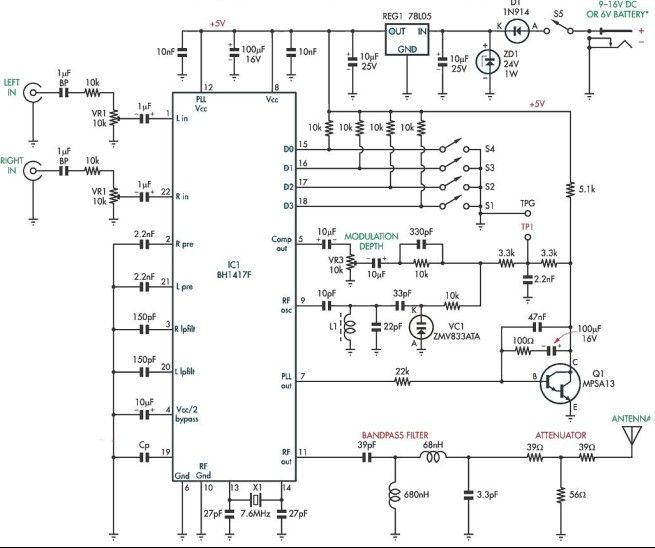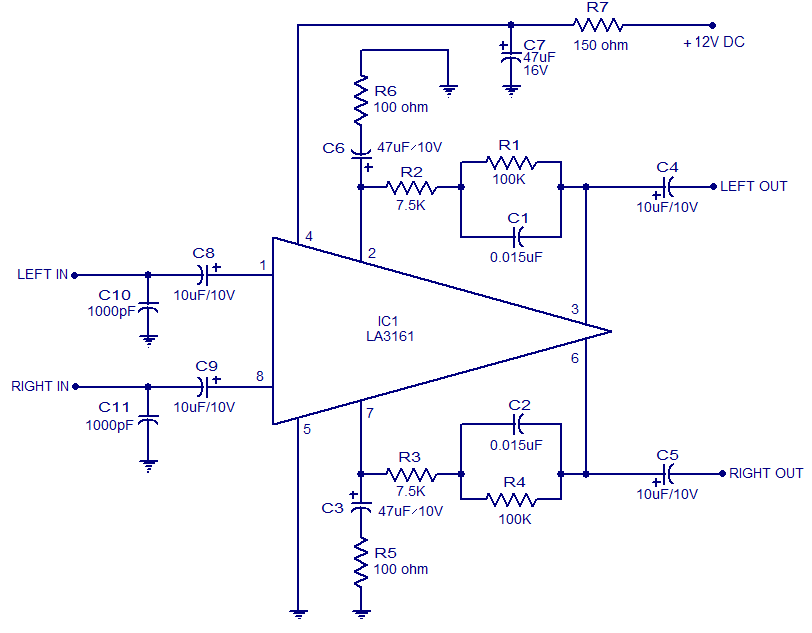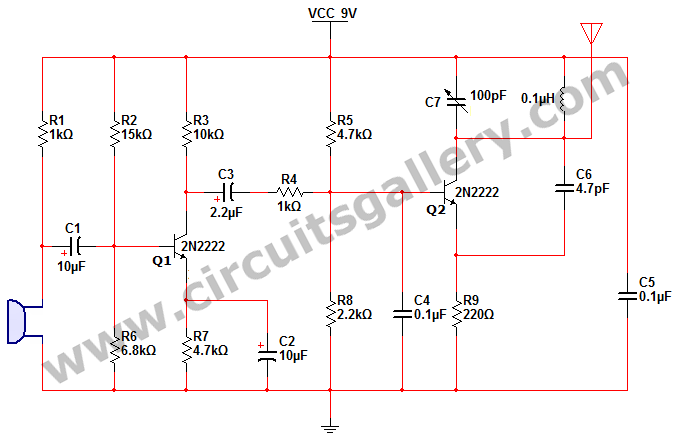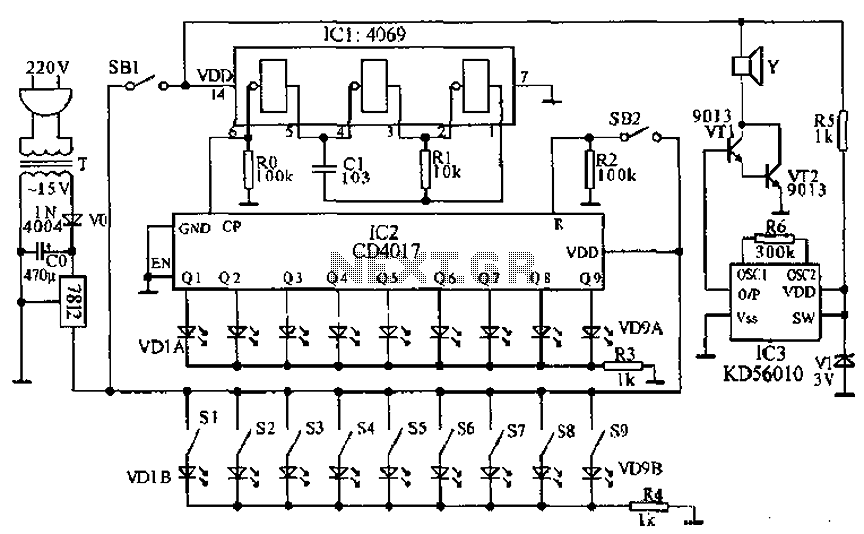
BH1417F FM stereo transmitter electronic project

This stereo FM modulator circuit utilizes the BH1417F FM stereo transmitter integrated circuit (IC), which includes a stereo modulator for generating stereo composite signals and an FM transmitter for broadcasting an FM signal wirelessly. The stereo modulator produces a composite signal that incorporates the MAIN, SUB, and pilot signals derived from a 38 kHz oscillator. The BH1417F stereo FM transmitter is capable of broadcasting high-quality signals over a distance of approximately 20 meters, making it suitable for transmitting music from a CD player or other signal sources for reception in different locations. The L1 coil consists of 2.5 turns of 0.5 - 1 mm enameled copper wire (ECW) wound onto a tapped coil former equipped with an F29 ferrite slug. Alternatively, a commercially available variable coil with 2.5 turns may also be utilized.
The BH1417F FM stereo transmitter circuit is designed to facilitate the effective transmission of audio signals over short distances using frequency modulation. The core component, the BH1417F IC, integrates both the stereo modulation and transmission functionalities, allowing for efficient signal processing and broadcasting. The stereo modulator within the IC generates a composite audio signal by combining the left (MAIN) and right (SUB) audio channels, along with a pilot tone at 19 kHz, which is essential for demodulating the stereo signal at the receiver end.
The oscillator circuit operates at 38 kHz, which is critical for the generation of the pilot tone and for maintaining the integrity of the stereo signal. This ensures that the receiver can accurately reconstruct the audio channels, providing a high-fidelity listening experience. The design of the L1 coil is important for the tuning and stability of the transmitter. The specified coil, constructed with 2.5 turns of enameled copper wire, contributes to the resonant characteristics necessary for efficient signal transmission. The inclusion of a ferrite slug allows for tuning adjustments, enhancing the circuit's performance.
This circuit is particularly advantageous for applications such as personal broadcasting, where users wish to transmit audio content from portable devices to nearby FM receivers. Its range of approximately 20 meters makes it suitable for home use, events, or demonstrations, where audio signals need to be shared without the constraints of wired connections. Overall, the BH1417F FM stereo modulator circuit represents a practical solution for wireless audio transmission, combining simplicity in design with effective performance.This stereo FM stereo modulator circuit use the BH1417F FM stereo transmitter IC which consists of a stereo modulator for generating stereo composite signals and a FM transmitter for broadcasting a FM signal on the air. The stereo modulator generates a composite signal which consists of the MAIN, SUB, and pilot signal from a 38kHz oscillator.
This BH1417F stereo FM transmitter is capable of broadcasting good quality signals over a range of about 20 meters and is ideal for broadcasting music from a CD player or from any other signal source so that it can be picked up in another location. L1 coil comprises 2. 5 turns of 0. 5 - 1mm enamelled copper wire (ECW) wound onto a tapped coil former fitted with an F29 ferrite slug. Alternatively, you may also use any commercially made 2. 5 turns variable coil. 🔗 External reference
The BH1417F FM stereo transmitter circuit is designed to facilitate the effective transmission of audio signals over short distances using frequency modulation. The core component, the BH1417F IC, integrates both the stereo modulation and transmission functionalities, allowing for efficient signal processing and broadcasting. The stereo modulator within the IC generates a composite audio signal by combining the left (MAIN) and right (SUB) audio channels, along with a pilot tone at 19 kHz, which is essential for demodulating the stereo signal at the receiver end.
The oscillator circuit operates at 38 kHz, which is critical for the generation of the pilot tone and for maintaining the integrity of the stereo signal. This ensures that the receiver can accurately reconstruct the audio channels, providing a high-fidelity listening experience. The design of the L1 coil is important for the tuning and stability of the transmitter. The specified coil, constructed with 2.5 turns of enameled copper wire, contributes to the resonant characteristics necessary for efficient signal transmission. The inclusion of a ferrite slug allows for tuning adjustments, enhancing the circuit's performance.
This circuit is particularly advantageous for applications such as personal broadcasting, where users wish to transmit audio content from portable devices to nearby FM receivers. Its range of approximately 20 meters makes it suitable for home use, events, or demonstrations, where audio signals need to be shared without the constraints of wired connections. Overall, the BH1417F FM stereo modulator circuit represents a practical solution for wireless audio transmission, combining simplicity in design with effective performance.This stereo FM stereo modulator circuit use the BH1417F FM stereo transmitter IC which consists of a stereo modulator for generating stereo composite signals and a FM transmitter for broadcasting a FM signal on the air. The stereo modulator generates a composite signal which consists of the MAIN, SUB, and pilot signal from a 38kHz oscillator.
This BH1417F stereo FM transmitter is capable of broadcasting good quality signals over a range of about 20 meters and is ideal for broadcasting music from a CD player or from any other signal source so that it can be picked up in another location. L1 coil comprises 2. 5 turns of 0. 5 - 1mm enamelled copper wire (ECW) wound onto a tapped coil former fitted with an F29 ferrite slug. Alternatively, you may also use any commercially made 2. 5 turns variable coil. 🔗 External reference





